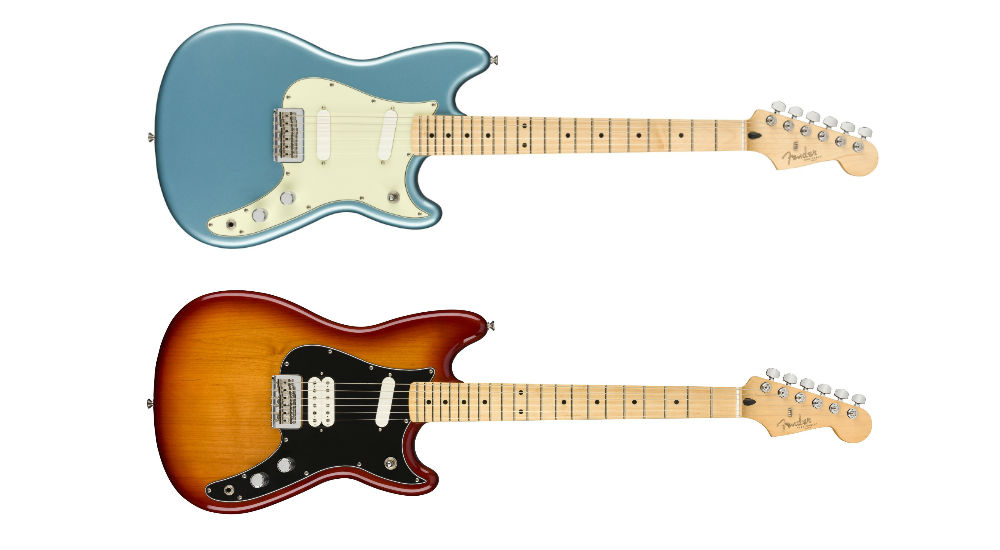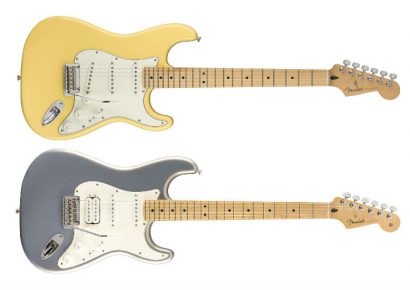The Duo-Sonic series of guitars were introduced as a two-pickup variant of the first offset Fender guitar: the Musicmaster. The original models were constructed from either ash, alder, or basswood, and underwent three slight revisions before being discontinued in 1969. In a similar fashion to Fender’s Lead Series, the Duo-Sonics were intermittently seen in the hands of legendary artists – David Byrne, Rory Gallagher, and a little player known then as Jimmy James, who later performed as Jimi Hendrix. Unfortunately, they never performed as well in the market as their Caster cousins, which eventually led to their discontinuation.
The guitar received three reissues – one Mexican-made re-release in 1993, and the second as part of Fender Squier’s Classic Vibe Series from 2008 to 2011. The final reintroduction of this axe took place in 2016 – where Fender unveiled the Duo-Sonic yet again as part of their new Mexican-made Offset Series. In recent years, Fender have combined their Offset and Player series of guitars to streamline their catalogue, finally allowing the Duo-Sonic to take their rightful place amongst their Caster counterparts. While their original purpose was tailored towards students, make no mistake. These guitars would serve guitar players of all skill levels well.
The pair of guitars up for review share only a few differences – their body finish, bridge pickup, and coil-splitting capabilities. The SS variant arrived in a tranquil blue Tidepool finish, while the HS model flaunted a jaw-dropping Sienna Sunburst paintjob. This particular finish accentuates the natural alder swirls of the body, and is by far one of the best finishes I’ve ever seen from Fender. The company have been adding a tonne of killer colours across all of their lines recently, and it’s a decision we hope to see remain forever.
Even more than half a century later, the Duo-Sonics still retain their primary attractions. Both guitars are built from alder and feature a supremely welcoming 24” scale length, 22 medium jumbo frets, and a 9.5” radius maple fretboard. The modern “C”-shaped necks are finished in an extremely comfortable satin polyester, which makes traversing the fretboard as effortless as it is enjoyable. Both necks also bear subtle wood figuring across their whole length, which extend all the way up to their vintage ‘60s style Strat headstock.
The playability of these guitars is off the charts. The body size of a Duo-Sonic sits between a three-quarter and a full-sized guitar – intentionally targeted at younger or smaller-statured players. However, at no times do these instruments feel like a toy. Complicated, frustrating jazz chords suddenly became feasible and within reach with the Duo-Sonic’s smaller frame and scale length. While its offset cutouts may ever so slightly differ from a Strat, the design still adheres incredibly well to a player’s body, in either a sitting or standing position. Comfort is definitely not an issue here.
Fender have opted for a handful of changes from these guitars’ vintage models. Gone are the fiddly black plastic pickup selector switches, now instead replaced by a much more convenient three-way toggle switch on the guitar’s bottom horn. The unique bridge on the original Duo-Sonics is also succeeded by a hardtail Stratocaster bridge, allowing for easier intonation/action tweaking and better tuning stability. And finally, the black plastic volume and tone knobs have been removed in favour of classy knurled chrome knobs, which sit atop a single-piece pickguard.
Thankfully, one of the Duo-Sonic’s most distinguishing features have not been altered – their distinctive covered pickups. The Duo-Sonic was known for their specially voiced pickups, which allowed a player to easily rise above a band mix without dramatic EQ tweaks. Unlike a Stratocaster, the neck single coil is slanted downwards, allowing for a slightly increased presence in the upper midrange. This allows the Duo-Sonic to perform as a sonic chameleon of sorts; with a tone profile nestled somewhere between the throaty neck pickup of a Stratocaster and a Telecaster’s twangy bridge pickup.
For the SS model, it’s pretty standard fare here: two covered pickups, one sloped in the neck, and one fully horizontal in the bridge. The three-way toggle switch allows you to choose between each pickup in isolation, and both active simultaneously. The tone knob is especially potent on the SS model. Roll it back a notch, and you’ll find yourself in glassy Strat territory. Leave it wide open, and you’ll achieve a fairly balanced voice with just a hint of a quack in the middle selection, and a jangly tone on the bridge. These pickup voicings work a treat for all sorts of surf/alternative rock – music genres deeply ingrained within the DNA of the Duo-Sonic itself.
The HS variant is where things get interesting. This guitar still retains the slanted covered neck pickup, but now rocks a special Duo-Sonic humbucker in the bridge. My favourite rhythm tone out of the lot was with both pickups active – it retained the pleasant treble boost of the neck pickup while adding a bolstered low end with the humbucker’s increased output. The sheer flexibility of the HS loadout was a definite attraction. Simply pull up on the tone knob, and you’ve got access to two single coils again. Slam it back down and add a dirt pedal or two, and you’ve got grit and sustain for days. I’m unsure how far Fender have diverted away from the regular Player Series humbucker with this one, but they’ve definitely done nothing wrong here.
It was hard to pick favourites between the two, but I’d have to give it to the HS model, simply for its unrivalled tonal flexibility and its stunning Sienna Sunburst finish. Both guitars performed identically, however. If you want a truly vintage look and voice, go for the SS. If you’d prefer a touch more modernity and variability, pick the HS. Unfortunately, certain finishes are exclusive for each guitar, which is a slight letdown.
By and large, these guitars have preserved their retro charm and ravishing good looks with a refined selection of modern appointments. With the popularity of offset-style guitars taking off in recent times, 2020 may truly signify the resurgence of the Duo-Sonic.

